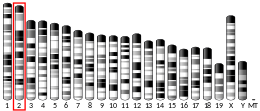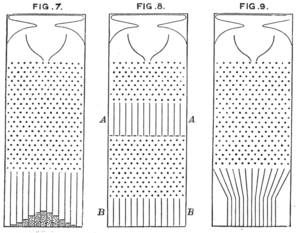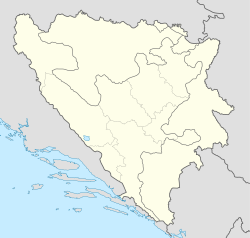노시케프틴수용체
Nociceptin receptornociceptin opioid 펩타이드 수용체(NOP),는 nociceptin/orphanin FQ(N/OFQ) 수용체 또는 카파형 3 오피오이드 수용체로 알려져 있으며, 인간 내에서는 OPRL1(opioid reception like 1) 유전자에 의해 인코딩되는 단백질이다.[5] nociceptin 수용체는 천연 리간드가 nociceptin(N/OFQ)으로 알려진 17개의 아미노산 신경펩타이드인 G 단백질 결합 수용체의 오피오이드 하위 계열의 일원이다.[6] 이 수용기는 수많은 뇌 활동, 특히 본능적이고 감정적인 행동의 조절에 관여한다.[7] NOP를 대상으로 하는 대항제들은 우울증과 파킨슨병 치료제 역할을 한 것으로 조사 중이며, NOP 작용제들은 인간이 아닌 영장류에서 강력한 비중독성 진통제로 작용하고 있는 것으로 나타났다.
NOP는 '클래식' 오피오이드 수용체 μ-OP(MOP), μ-OP(KOP), Δ-OP(DOP)와 고순도 정체성(~60%)을 공유하지만 오피오이드 펩타이드나 모르핀 유사 화합물에 대한 친화력은 거의 또는 전혀 없다.[8] 마찬가지로 고전적인 오피오이드 수용체는 구조적으로 다이노핀 A와 관련이 있는 NOP의 내생성 리간드 노시케프틴에 대한 친화력이 거의 없다.[8]
디스커버리
1994년 몰레라우 외는 Nociceptin Opioid Peptide 수용체(NOP)로 알려진 기존의 오피오리드 수용체(OPs) μ-OR(MOP), κ-OR(KOP), Δ-OR(DOP)에 동질성이 높은 수용체를 복제했다.[9] 이러한 "일반적인" 오피오이드 수용체가 30년 전인 1960년대 중반에 확인되었기 때문에, NOP의 생리적, 약리적 특성화뿐만 아니라 이 수용체를 대상으로 하는 치료적 발달도 수십 년 뒤에 남아 있다.[10][11] NOP에 대한 연구가 자체 하위 분야로 꽃을 피웠지만, NOP의 존재에 대한 광범위한 지식이 없다는 것은 치료 대상으로서의 전도유망한 역할에도 불구하고 OP 계열을 조사하는 연구에서 일반적으로 생략된다는 것을 의미한다.
메커니즘과 약리학
NOP 셀룰러 신호 전달 파트너
대부분의 G단백 결합 수용체와 마찬가지로 NOP는 활성화 시 표준 G단백질을 통해 신호를 보낸다. G단백질이란 α, β, γ 서브유닛으로 구성된 이단 복합체다. NOP는 다양한 다운스트림 신호 캐스케이드를 트리거하는 다양한 Gα 하위 유형을 통해 신호를 보낸다. Gαi 또는 Gαo 서브유닛에 대한 NOP 결합은 많은 신호 전달 경로에 중요한 두 번째 메신저인 순환 아데노신 모노인산염(cAMP) 수준의 세포 내 감소를 유발하는 아데닐 시클라아제(AC) 억제로 이어진다.[12][13] 또한 Gαi/o 경로를 통해 작용하는 NOP는 PLA2(인산리파제 A2)를 활성화하여 미토겐 활성 단백질키나제(MAPK) 신호 캐스케이드를 개시하는 것으로 나타났다.[14] 또한 NOP는 기존의 OP와 대조적으로 Pertusis 독소(PTX)-감응성이 없는 하위 유형 Gαz, Gα14, Gα와16 결합하며 잠재적으로 Gα와12 Gα도 결합한다.[15][16][17] NOP의 표준 β-아레스틴 경로의 활성화는 수용체 인산화, 내적화, 궁극적으로는 다운조절과 재활용을 유발한다.[18][19] 또한 NOP 활성화는 오피오이드 수용체 MOP와 KOP의 간접 억제를 유발하여 특정 조직에서 항오피오이드 활성을 유발한다. 또한 NOP 활성화는 칼륨 채널의 활성화와 칼슘 채널의 억제로 이어져 뉴런 발화를 집단적으로 억제한다.[20][21][22]
신경안내술
Nociceptin은 nociception에서 음식 섭취, 기억 과정에서부터 심혈관 및 신장 기능, 자발적 기관차 활동에서 위장 운동성, 불안감에서 주변 및 중앙 부위의 신경 전달 물질 방출 제어에 이르기까지 광범위한 생물학적 기능을 제어한다.[23]
통증회로
뇌 통증 회로에 대한 NOP 활성화 결과는 현장마다 다르다. 중추신경계 내에서 그 작용은 위치에 따라 오피오이드와 비슷하거나 반대일 수 있다.[23] 동물 모델에서는 뇌간에서 NOP가 활성화되고 뇌영역이 높아지면서 작용이 엇갈려 전반적인 항오피오이드 활성화가 일어난다. 척수와 말초신경계에서의 NOP 활성화는 인간이 아닌 영장류에서 모르핀과 비교할 수 없는 진통증을 유발한다.
리워드 회로
NOP는 중격포상회로의 모든 노드에서 고도로 표현된다. 코딘, 모르핀 등 MOP 작용제와 달리 NOP 작용제는 강화 효과가 없다. Nociceptin은 도파민에 직접 작용하거나 GABA가 도파민 수치에 영향을 미치도록 억제함으로써 도파민 수송의 내생적인 길항제라고 생각된다.[24] 동물 모델에서는 중추신경계의 NOP 활성화 결과가 모르핀, 코카인, 알코올, 필로폰에 의해 유도된 조건화된 장소 선호도를 없앤 것으로 나타났다.[25]
치료 잠재력
진통 및 남용 책임
최근의 연구는 NOP를 목표로 하는 것이 전통적인 MOP 활성화 오피오이드 치료법의 해로운 부작용 없이 고통을 완화시킬 수 있는 유망한 대안 경로라는 것을 보여준다.[26][27][28][29][30][31] 영장류에서 특히 전신 또는 경막내 투여를 통해 NOP를 활성화하면 가려움, 호흡기 우울증, 또는 정맥 내 자가 관리 패러다임에서 중독을 초래하는 보강 효과 없이 오래 지속되고 모르핀과 비교할 수 없는 진통제를 유도하여 현재 오피오이의 심각한 부작용을 모두 제거한다.d [31]요법
에토핀과 부프레노핀을 포함하여 일반적으로 사용되는 여러 오피오이드 약물이 nociceptin 수용체에 결합하는 것으로 입증되었지만, 급성 환경에서 다른 오피오이드 수용체에서의 활성도에 비해 이 결합은 상대적으로 미미하다(그러나 비분석적 NOPr 길항제 SB-612,111은 치료 b에 힘을 실어주는 것으로 입증되었다).모르핀의 진통제 만성적인 nociceptin 수용체 작용제의 투여는 아산화물의 진통 효과와 항알로디닉 효과의 감소를 초래한다; 이 메커니즘은 내생 오피오이드의 작용도 억제하여 만성 NOPr 작용제 관리자에 따른 통증 심각도, 우울증, 신체적 및 심리적 아산화물의 의존도 증가를 초래한다.발톱질질질질질질질질질질질질질질하다[32] NOPr 길항제 SB-612,111의 행정은 이 과정을 억제하는 것으로 나타났다.[33] 보다 최근에는 다른 오피오이드 수용체에 대한 친화력이 거의 또는 전혀 보이지 않는 NOP에 대한 선택적 리간드가 개발되어 NOP 매개 반응을 격리하여 연구할 수 있게 되었다.
고민자
- AT-121(µ-opioid 수용체와 nociceptin 수용체 모두의 실험 작용제로서, 인간이 아닌 영장류에서 유망한 결과를 보여준다.)
- 부프레노핀(NOP에 대해 선택적이지 않은 부분작용제, 또한 µ-opioid 수용체의 부분작용제, Δ-opioid 수용체와 --opioid 수용체의 경쟁적 길항제)
- BU08028(부프레노핀, 부분작용제, µ-오피오이드 수용체의 작용제는 물리적인 의존성이 없는 진통 성질을 가지고 있다.)[34]
- 세브라노파돌(NOP, μ-opioid 수용체 및 Δ-opioid 수용체에서 완전작용제, μ-opioid 수용체에서 부분작용제)
- 에토핀
- MCOPPB[35](완전 작용제)
- MT-7716
- Nociceptin
- 노르부프레노핀(완전 작용제, 비선택성(MOR 및 DOR에서 완전 작용제, KOR에서 부분작용제), 주변 선택성)
- NNC 63-0532
- 로64-6198번길
- 로65-6570번길
- SCH-221,510
- SR-8993
- SR-16435(혼합 MOR/NOP 부분작용제)
- TH-030418
반목자
적용들
노프 작용제는 심부전과 편두통의[36] 치료제로 연구되고 있는 반면, JTC-801과 같은 노키셉틴 길항제들은 진통성과[37] 항우울제 성질을 가지고 있을 수 있다.[38]
참조
- ^ a b c ENSG00000125510 GRCh38: 앙상블 릴리스 89: ENSG00000277044, ENSG00000125510 - 앙상블, 2017년 5월
- ^ a b c GRCm38: 앙상블 릴리스 89: ENSMUSG000027584 - 앙상블, 2017년 5월
- ^ "Human PubMed Reference:". National Center for Biotechnology Information, U.S. National Library of Medicine.
- ^ "Mouse PubMed Reference:". National Center for Biotechnology Information, U.S. National Library of Medicine.
- ^ Mollereau C, Parmentier M, Mailleux P, Butour JL, Moisand C, Chalon P, Caput D, Vassart G, Meunier JC (March 1994). "ORL1, a novel member of the opioid receptor family. Cloning, functional expression and localization". FEBS Letters. 341 (1): 33–8. doi:10.1016/0014-5793(94)80235-1. PMID 8137918. S2CID 25491521.
- ^ Henderson G, McKnight AT (August 1997). "The orphan opioid receptor and its endogenous ligand--nociceptin/orphanin FQ". Trends in Pharmacological Sciences. 18 (8): 293–300. doi:10.1016/S0165-6147(97)90645-3. PMID 9277133.
- ^ "Entrez Gene: OPRL1 opiate receptor-like 1".
- ^ a b Butour JL, Moisand C, Mazarguil H, Mollereau C, Meunier JC (February 1997). "Recognition and activation of the opioid receptor-like ORL 1 receptor by nociceptin, nociceptin analogs and opioids". European Journal of Pharmacology. 321 (1): 97–103. doi:10.1016/S0014-2999(96)00919-3. PMID 9083791.
- ^ Mollereau C, Parmentier M, Mailleux P, Butour JL, Moisand C, Chalon P, Caput D, Vassart G, Meunier JC (March 1994). "ORL1, a novel member of the opioid receptor family. Cloning, functional expression and localization". FEBS Letters. 341 (1): 33–8. doi:10.1016/0014-5793(94)80235-1. PMID 8137918. S2CID 25491521.
- ^ Martin WR (December 1967). "Opioid antagonists". Pharmacological Reviews. 19 (4): 463–521. PMID 4867058.
- ^ Goldstein A, Lowney LI, Pal BK (August 1971). "Stereospecific and nonspecific interactions of the morphine congener levorphanol in subcellular fractions of mouse brain". Proceedings of the National Academy of Sciences of the United States of America. 68 (8): 1742–7. Bibcode:1971PNAS...68.1742G. doi:10.1073/pnas.68.8.1742. PMC 389284. PMID 5288759.
- ^ Meunier JC, Mollereau C, Toll L, Suaudeau C, Moisand C, Alvinerie P, Butour JL, Guillemot JC, Ferrara P, Monsarrat B (October 1995). "Isolation and structure of the endogenous agonist of opioid receptor-like ORL1 receptor". Nature. 377 (6549): 532–5. Bibcode:1995Natur.377..532M. doi:10.1038/377532a0. PMID 7566152. S2CID 4326860.
- ^ Reinscheid RK, Nothacker HP, Bourson A, Ardati A, Henningsen RA, Bunzow JR, Grandy DK, Langen H, Monsma FJ, Civelli O (1995). "Orphanin FQ: a neuropeptide that activates an opioidlike G protein-coupled receptor". Science. 270 (5237): 792–4. Bibcode:1995Sci...270..792R. doi:10.1126/science.270.5237.792. PMID 7481766. S2CID 38117854.
- ^ Fukuda K, Shoda T, Morikawa H, Kato S, Mima H, Mori K (1998). "Activation of phospholipase A2 by the nociceptin receptor expressed in Chinese hamster ovary cells". Journal of Neurochemistry. 71 (5): 2186–92. doi:10.1046/j.1471-4159.1998.71052186.x. PMID 9798946. S2CID 22919153.
- ^ Childers SR, Snyder SH (1978). "Guanine nucleotides differentiate agonist and antagonist interactions with opiate receptors". Life Sciences. 23 (7): 759–61. doi:10.1016/0024-3205(78)90077-2. PMID 211364.
- ^ Chan JS, Yung LY, Lee JW, Wu YL, Pei G, Wong YH (1998). "Pertussis toxin-insensitive signaling of the ORL1 receptor: coupling to Gz and G16 proteins". Journal of Neurochemistry. 71 (5): 2203–10. doi:10.1046/j.1471-4159.1998.71052203.x. PMID 9798948. S2CID 7978426.
- ^ Yung LY, Joshi SA, Chan RY, Chan JS, Pei G, Wong YH (January 1999). "GalphaL1 (Galpha14) couples the opioid receptor-like1 receptor to stimulation of phospholipase C". The Journal of Pharmacology and Experimental Therapeutics. 288 (1): 232–8. PMID 9862775.
- ^ Dhawan BN, Cesselin F, Raghubir R, Reisine T, Bradley PB, Portoghese PS, Hamon M (December 1996). "International Union of Pharmacology. XII. Classification of opioid receptors". Pharmacological Reviews. 48 (4): 567–92. PMID 8981566.
- ^ Donica CL, Awwad HO, Thakker DR, Standifer KM (May 2013). "Cellular mechanisms of nociceptin/orphanin FQ (N/OFQ) peptide (NOP) receptor regulation and heterologous regulation by N/OFQ". Molecular Pharmacology. 83 (5): 907–18. doi:10.1124/mol.112.084632. PMC 3629824. PMID 23395957.
- ^ Connor M, Yeo A, Henderson G (1996). "The effect of nociceptin on Ca2+ channel current and intracellular Ca2+ in the SH-SY5Y human neuroblastoma cell line". British Journal of Pharmacology. 118 (2): 205–7. doi:10.1111/j.1476-5381.1996.tb15387.x. PMC 1909632. PMID 8735615.
- ^ Connor M, Vaughan CW, Chieng B, Christie MJ (1996). "Nociceptin receptor coupling to a potassium conductance in rat locus coeruleus neurones in vitro". British Journal of Pharmacology. 119 (8): 1614–8. doi:10.1111/j.1476-5381.1996.tb16080.x. PMC 1915781. PMID 8982509.
- ^ Ikeda K, Kobayashi T, Kumanishi T, Niki H, Yano R (2000). "Involvement of G-protein-activated inwardly rectifying K (GIRK) channels in opioid-induced analgesia". Neuroscience Research. 38 (1): 113–6. doi:10.1016/S0168-0102(00)00144-9. PMID 10997585. S2CID 29108127.
- ^ a b Calo' G, Guerrini R, Rizzi A, Salvadori S, Regoli D (April 2000). "Pharmacology of nociceptin and its receptor: a novel therapeutic target". British Journal of Pharmacology. 129 (7): 1261–83. doi:10.1038/sj.bjp.0703219. PMC 1571975. PMID 10742280.
- ^ Liu Z, Wang Y, Zhang J, Ding J, Guo L, Cui D, Fei J (March 2001). "Orphanin FQ: an endogenous antagonist of rat brain dopamine transporter". NeuroReport. 12 (4): 699–702. doi:10.1097/00001756-200103260-00017. PMID 11277567. S2CID 27631391.
- ^ Toll L, Bruchas MR, Calo' G, Cox BM, Zaveri NT (April 2016). "Nociceptin/Orphanin FQ Receptor Structure, Signaling, Ligands, Functions, and Interactions with Opioid Systems". Pharmacological Reviews. 68 (2): 419–57. doi:10.1124/pr.114.009209. PMC 4813427. PMID 26956246.
- ^ Lin AP, Ko MC (February 2013). "The therapeutic potential of nociceptin/orphanin FQ receptor agonists as analgesics without abuse liability". ACS Chemical Neuroscience. 4 (2): 214–24. doi:10.1021/cn300124f. PMC 3582300. PMID 23421672.
- ^ Sukhtankar DD, Zaveri NT, Husbands SM, Ko MC (July 2013). "Effects of spinally administered bifunctional nociceptin/orphanin FQ peptide receptor/μ-opioid receptor ligands in mouse models of neuropathic and inflammatory pain". The Journal of Pharmacology and Experimental Therapeutics. 346 (1): 11–22. doi:10.1124/jpet.113.203984. PMC 3684842. PMID 23652222.
- ^ Hu E, Calò G, Guerrini R, Ko MC (January 2010). "Long-lasting antinociceptive spinal effects in primates of the novel nociceptin/orphanin FQ receptor agonist UFP-112". Pain. 148 (1): 107–13. doi:10.1016/j.pain.2009.10.026. PMC 2861283. PMID 19945794.
- ^ Ko MC, Wei H, Woods JH, Kennedy RT (September 2006). "Effects of intrathecally administered nociceptin/orphanin FQ in monkeys: behavioral and mass spectrometric studies". The Journal of Pharmacology and Experimental Therapeutics. 318 (3): 1257–64. doi:10.1124/jpet.106.106120. PMID 16766718. S2CID 9537945.
- ^ Ko MC, Naughton NN (May 2009). "Antinociceptive effects of nociceptin/orphanin FQ administered intrathecally in monkeys". The Journal of Pain. 10 (5): 509–16. doi:10.1016/j.jpain.2008.11.006. PMC 2797530. PMID 19231294.
- ^ a b Ko MC, Woods JH, Fantegrossi WE, Galuska CM, Wichmann J, Prinssen EP (August 2009). "Behavioral effects of a synthetic agonist selective for nociceptin/orphanin FQ peptide receptors in monkeys". Neuropsychopharmacology. 34 (9): 2088–96. doi:10.1038/npp.2009.33. PMC 2804925. PMID 19279568.
- ^ Khroyan TV, Polgar WE, Orduna J, Montenegro J, Jiang F, Zaveri NT, Toll L (November 2011). "Differential effects of nociceptin/orphanin FQ (NOP) receptor agonists in acute versus chronic pain: studies with bifunctional NOP/μ receptor agonists in the sciatic nerve ligation chronic pain model in mice". The Journal of Pharmacology and Experimental Therapeutics. 339 (2): 687–93. doi:10.1124/jpet.111.184663. PMC 3199991. PMID 21859931.
- ^ Zaratin PF, Petrone G, Sbacchi M, Garnier M, Fossati C, Petrillo P, Ronzoni S, Giardina GA, Scheideler MA (February 2004). "Modification of nociception and morphine tolerance by the selective opiate receptor-like orphan receptor antagonist (-)-cis-1-methyl-7-[ [4-(2,6-dichlorophenyl)piperidin-1-yl]methyl]-6,7,8,9-tetrahydro-5H-benzocyclohepten-5-ol (SB-612111)". The Journal of Pharmacology and Experimental Therapeutics. 308 (2): 454–61. doi:10.1124/jpet.103.055848. PMID 14593080. S2CID 8036750.
- ^ Ding H, Czoty PW, Kiguchi N, Cami-Kobeci G, Sukhtankar DD, Nader MA, et al. (September 2016). "A novel orvinol analog, BU08028, as a safe opioid analgesic without abuse liability in primates". Proceedings of the National Academy of Sciences of the United States of America. 113 (37): E5511–8. doi:10.1073/pnas.1605295113. PMC 5027459. PMID 27573832. S2CID 36624494.
- ^ Hirao A, Imai A, Sugie Y, Yamada Y, Hayashi S, Toide K (March 2008). "Pharmacological characterization of the newly synthesized nociceptin/orphanin FQ-receptor agonist 1-[1-(1-methylcyclooctyl)-4-piperidinyl]-2-[(3R)-3-piperidinyl]-1H-benzimidazole as an anxiolytic agent". Journal of Pharmacological Sciences. 106 (3): 361–8. doi:10.1254/jphs.fp0071742. PMID 18319566.
- ^ Mørk H, Hommel K, Uddman R, Edvinsson L, Jensen R (September 2002). "Does nociceptin play a role in pain disorders in man?". Peptides. 23 (9): 1581–7. doi:10.1016/S0196-9781(02)00101-8. PMID 12217418. S2CID 22718102.
- ^ Scoto GM, Aricò G, Ronsisvalle S, Parenti C (July 2007). "Blockade of the nociceptin/orphanin FQ/NOP receptor system in the rat ventrolateral periaqueductal gray potentiates DAMGO analgesia". Peptides. 28 (7): 1441–6. doi:10.1016/j.peptides.2007.05.013. PMID 17628212. S2CID 29027947.
- ^ Redrobe JP, Calo' G, Regoli D, Quirion R (February 2002). "Nociceptin receptor antagonists display antidepressant-like properties in the mouse forced swimming test". Naunyn-Schmiedeberg's Archives of Pharmacology. 365 (2): 164–7. doi:10.1007/s00210-001-0511-0. PMID 11819035. S2CID 25596953.
추가 읽기
- Mollereau C, Mouledous L (July 2000). "Tissue distribution of the opioid receptor-like (ORL1) receptor". Peptides. 21 (7): 907–17. doi:10.1016/S0196-9781(00)00227-8. PMID 10998524. S2CID 13294560.
- New DC, Wong YH (2003). "The ORL1 receptor: molecular pharmacology and signalling mechanisms". Neuro-Signals. 11 (4): 197–212. doi:10.1159/000065432. PMID 12393946.
- Zaveri N (June 2003). "Peptide and nonpeptide ligands for the nociceptin/orphanin FQ receptor ORL1: research tools and potential therapeutic agents". Life Sciences. 73 (6): 663–78. doi:10.1016/S0024-3205(03)00387-4. PMC 3848886. PMID 12801588.
- Wick MJ, Minnerath SR, Roy S, Ramakrishnan S, Loh HH (September 1995). "Expression of alternate forms of brain opioid 'orphan' receptor mRNA in activated human peripheral blood lymphocytes and lymphocytic cell lines". Brain Research. Molecular Brain Research. 32 (2): 342–7. doi:10.1016/0169-328X(95)00096-B. PMID 7500847.
- Meunier JC, Mollereau C, Toll L, Suaudeau C, Moisand C, Alvinerie P, Butour JL, Guillemot JC, Ferrara P, Monsarrat B (October 1995). "Isolation and structure of the endogenous agonist of opioid receptor-like ORL1 receptor". Nature. 377 (6549): 532–5. Bibcode:1995Natur.377..532M. doi:10.1038/377532a0. PMID 7566152. S2CID 4326860.
- Yung LY, Joshi SA, Chan RY, Chan JS, Pei G, Wong YH (January 1999). "GalphaL1 (Galpha14) couples the opioid receptor-like1 receptor to stimulation of phospholipase C". The Journal of Pharmacology and Experimental Therapeutics. 288 (1): 232–8. PMID 9862775.
- Feild JA, Foley JJ, Testa TT, Nuthulaganti P, Ellis C, Sarau HM, Ames RS (October 1999). "Cloning and characterization of a rabbit ortholog of human Galpha16 and mouse G(alpha)15". FEBS Letters. 460 (1): 53–6. doi:10.1016/S0014-5793(99)01317-4. PMID 10571060. S2CID 86483726.
- Mouledous L, Topham CM, Moisand C, Mollereau C, Meunier JC (March 2000). "Functional inactivation of the nociceptin receptor by alanine substitution of glutamine 286 at the C terminus of transmembrane segment VI: evidence from a site-directed mutagenesis study of the ORL1 receptor transmembrane-binding domain". Molecular Pharmacology. 57 (3): 495–502. doi:10.1124/mol.57.3.495. PMID 10692489.
- Yung LY, Tsim KW, Pei G, Wong YH (2000). "Immunoglobulin G1 Fc fragment-tagged human opioid receptor-like receptor retains the ability to inhibit cAMP accumulation". Biological Signals and Receptors. 9 (5): 240–7. doi:10.1159/000014645. PMID 10965058. S2CID 32796564.
- Ito E, Xie G, Maruyama K, Palmer PP (December 2000). "A core-promoter region functions bi-directionally for human opioid-receptor-like gene ORL1 and its 5'-adjacent gene GAIP". Journal of Molecular Biology. 304 (3): 259–70. doi:10.1006/jmbi.2000.4212. PMID 11090272.
- Okada K, Sujaku T, Chuman Y, Nakashima R, Nose T, Costa T, Yamada Y, Yokoyama M, Nagahisa A, Shimohigashi Y (November 2000). "Highly potent nociceptin analog containing the Arg-Lys triple repeat". Biochemical and Biophysical Research Communications. 278 (2): 493–8. doi:10.1006/bbrc.2000.3822. PMID 11097863.
- Serhan CN, Fierro IM, Chiang N, Pouliot M (March 2001). "Cutting edge: nociceptin stimulates neutrophil chemotaxis and recruitment: inhibition by aspirin-triggered-15-epi-lipoxin A4". Journal of Immunology. 166 (6): 3650–4. doi:10.4049/jimmunol.166.6.3650. PMID 11238602.
- Mandyam CD, Thakker DR, Christensen JL, Standifer KM (August 2002). "Orphanin FQ/nociceptin-mediated desensitization of opioid receptor-like 1 receptor and mu opioid receptors involves protein kinase C: a molecular mechanism for heterologous cross-talk". The Journal of Pharmacology and Experimental Therapeutics. 302 (2): 502–9. doi:10.1124/jpet.102.033159. PMID 12130708. S2CID 16475164.
- Thakker DR, Standifer KM (September 2002). "Orphanin FQ/nociceptin blocks chronic morphine-induced tyrosine hydroxylase upregulation". Brain Research. Molecular Brain Research. 105 (1–2): 38–46. doi:10.1016/S0169-328X(02)00390-X. PMID 12399106.
- Spampinato S, Di Toro R, Alessandri M, Murari G (December 2002). "Agonist-induced internalization and desensitization of the human nociceptin receptor expressed in CHO cells". Cellular and Molecular Life Sciences. 59 (12): 2172–83. doi:10.1007/s000180200016. PMID 12568343. S2CID 24462875.
외부 링크
- "Opioid Receptors: NOP". IUPHAR Database of Receptors and Ion Channels. International Union of Basic and Clinical Pharmacology.
- 미국 국립 의학 도서관의 Nociceptin+수용체(MesH)
- PDBe-KB에서 UniProt: P41146(Nociceptin 수용체)에 대해 PDB에서 사용할 수 있는 모든 구조 정보의 개요.
이 기사는 공공영역에 있는 미국 국립 의학 도서관의 텍스트를 통합하고 있다.






